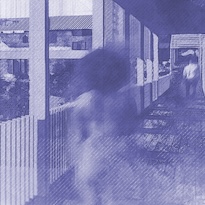Architecture and temporality
Saint-Pierre: The forgotten museum city
Abstract
On 8 May 1902, at 7:52 a.m., the city of Saint-Pierre was no more, ravaged by the Pelean eruption
of its Montagne. In a matter of seconds, one of the Caribbean's most important cities was wiped out.
More than a century later, life goes on, leaving the ruins as a reminder of a past not to be forgotten.
But this former capital, emptied of its 30,000 inhabitants on the eve of the eruption, is still struggling
to regain its former dynamism and glory.
And yet, nestled in a gully high above the city, Domaine DIKI's architecture blends history, culture
and modernity to create a sensitive setting. With its large overhanging roofs in the colors of tropical
dwellings, the rehabilitation of the ruins of this former dwelling once again resonates as a touch of
hope and rebirth.
Despite the looming threat of risk, the project finds its place and flourishes alongside the surrounding
nature, reminding us perhaps that architecture is first and foremost about accepting that not
everything can be mastered, and that risk is reason enough to make it worthwhile to exist even for a
moment.
Downloads

Downloads
Published
How to Cite
Issue
Section
License
Copyright (c) 2023 Camille Renard

This work is licensed under a Creative Commons Attribution 4.0 International License.
The authors keep their rights upon their work, although they transfer, in a non-exclusive way, the rights of exploitation (reproduction, publication, distribution, public dissemination and presentation) to the Journal. The authors are, therefore, free to enter additional, separate contracts for the non-exclusive distribution of the version of the work published in the Journal (for instance, by hosting in an institutional repository or publication in a book), provided credit is given that the work was initially published in this journal. The works are published under a Creative Commons Attribution 4.0 (CC BY 4.0) license.











